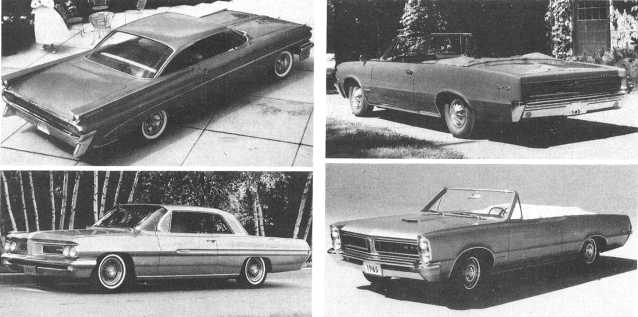
Clockwise, starting from top-left: 1959 Catalina Sport Coupe had the now-famous Pontiac wide-track stance and a high-perf Tempest 420 V-8 engine that sat in a redesigned chassis. This was budget performance. The '64 GTO represented sports car styling to the formerly staid Pontiac lineup. Bucket seats and a standard 389/325 GTO engine started the entire supercar thing! '65 GeeTo had a new hood with center air intake and also featured a special instrument cluster. Four-barrel 389 with synchromesh 3-speed was the 1965 mark of the GTO marque. '62 Grand Prix was a luxury barge, but there was some power there, too. Note special wheels which hinted at special interior appointments for the man who had arrived, but wanted to also arrive quicker!
 |
At the beginning of the '61 model year, the only change was a quarter point more compression on the Super Duty packages, although there were a couple of new camshaft grinds from Malcolm McKellar, who figured heavily in the development of all the early high performance pieces but who is especially known for his legendary camshafts. Ratings were raised to 368 horsepower at 5600 for both the tripower dragstrip version and the single 4-barrel NASCAR version. (Both actually put out over 400 horsepower with everything blueprinted.)
This was also another little trick Pontiac played in those days. While all the other Detroit manufacturers were putting super-inflated horsepower ratings on their engines, Pontiac's ratings were always very conservative. They either reflected the true output of the engine or, in special instances, actually underrated the engine.
Remember, this was before factoring of engine ratings. NHRA simply used the advertised horsepower rating and advertised shipping weight to determine classifications. By underrating their engines, Pontiacs always enjoyed favorable classification and could run against engines putting out sometimes only half the actual power. It doesn't matter how you play the game. It's the victory that counts.
However, the winds of defeat were starting to blow around Wide Track Boulevard. Ford's '61 super stock engine was 390 cubes and 401 horsepower. It was doing the job to the 389/368 Pontiacs. In addition, Chevrolet had just introduced their 409 and Dodge and Plymouth were using the big Chrysler 413 engine in the smaller Dart and Fury bodies. Pontiac had to do something.
They did something. Just prior to the 1961 NHRA Nationals at Indianapolis, Pontiac introduced a new 421-cubic-inch engine. It was rated a ridiculously low 373 horsepower and the only people who could get them were the Mickey Thompson crew. The engines were so new that NHRA had to make a special class for them—Optional Super/Stock. Other cars in the class were Chevy's new dual quad 409/409 and Ford's new 406/405. As it turned out, Hayden Proffitt in Mickey Thompson's Catalina blew off everyone with a 12.55-110.20 blast, which was unheard of in 1961. Even a 13-second stocker was looked on as something incredible. By comparison, Lloyd and Carol Cox won the S/SA class with a time slip reading 13.80-105.63 with their 368 horsepower 389.
The new Super Duty 421 was basically a poked and stroked Super Duty 389. Bore was now 4.093 and stroke 4.00. The number ten McKellar camshaft was used along with a new dual 4-barrel intake setup on a high rise aluminum intake manifold. Compression was 11-to-one.
For '62, Pontiac's most successful year in super stock racing, the factory was forced to go the assembly line route by the new NHRA ruling which outlawed all the so-called dealer-installed performance options. Now everything had to be real production options right off the assembly line.
By this time, Bunkie Knudsen had moved over to the general managership of the Chevrolet Division and Pete Estes had taken over as Pontiac boss. He was all for the idea of the assembly line super stocker.
The price was stiff. The Super Duty 421 cost $1334.24 over the cost of the standard Catalina V-8. A mandatory option was the 4-speed trans for another $234. So the costs of super stock racing were high even 11 years ago. It was still cheaper than buying all the stuff separately, though.
Few people realize that there were two special Super Duty engines in 1962. Both were available only in the Catalina series, although some guys bought Catalinas, then fitted Grand Prix grilles to their cars. It came under the heading of "mild customizing" which was allowed under NHRA rules.
The Super Duty 389 was for NASCAR racing and was rated 385 horsepower with one 4-barrel carb on an aluminum intake manifold. Other than the bore and stroke, both the 389 and 421 were basically the same engine and used many similar parts. Both had 4-bolt mains, high capacity fuel pumps, heavy duty clutch, special front harmonic balancer, heavy duty bearings, dual point distributor, etc.
NEXT >
|